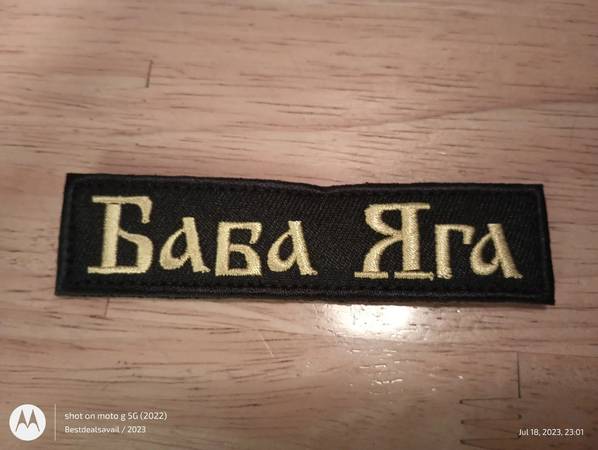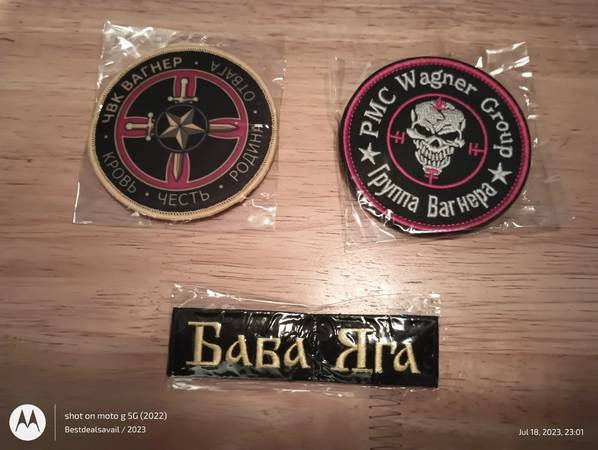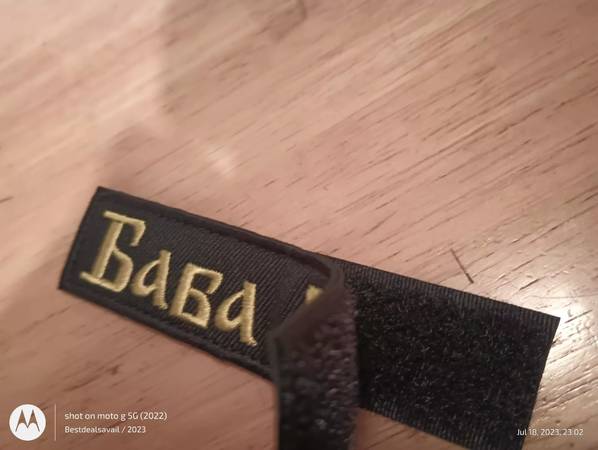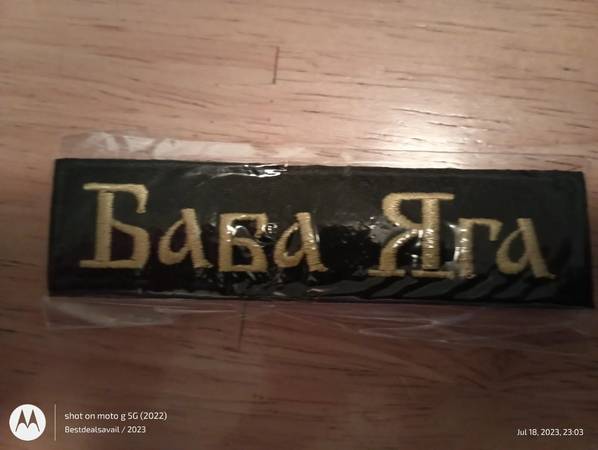




 18
18These items are for sale as part of modern history, military memorabilia and not associated with any preferences or any political views !!!!!!!!!!!!! For example same as listed from other sellers patches like Azov or Kraken. Baba Yaga (Boogeyman) Size: 4"*1"(10cm*2.5cm) Embroidered Tactical Hook Loop Badge Velcro set: three Patches. Price is for all three patches together. To sew looped sections of fabric (Clothes, bags, hats, etc.). Hooks are provided with the patch. Condition: Brand new, factory sealed, original authentic including two more Russian /Ukrainian patches (Size: 3.15" or 8 cm Lifespan of 100000 times) Material: High Grade Embroidered Thread. For shipping item also listed on eBay: https://www.ebay.com/itm/394776152153 Please check my other items for sale! Second " Yellow"patch in this set: PMC Wagner Group Embroidered Tactical Hook Loop Badge Velcro Patch. To sew looped sections of fabric (clothes, bags, hats, etc.). Hooks are provided with the patch. Condition: Brand new, factory sealed, original authentic patch for new members of Wagner Group Material: High Grade Embroidered Thread Size: 3.15" or 8 cm Lifespan of 100000 times. In 2022 this alternative logo was designed for the PMC Wagner. The new concept has replaced the skull with two swords, a star, and a cross. The Wagner motto has also changed, now based on “Blood, Honor, Homeland, and Courage”, written in yellow capitals at the bottom part of the roundel’s frame. The new color palette of the Wagner Group logo is based on an intense and dramatic tricolor, composed of black, red, and yellow. As for the color palette of the PMC Wagner visual identity, it has its two emblems set in two different schemes, although the combination of red and black makes the basis for both. These shades symbolize fight and war, making up an image with a dangerous and aggressive mood. As for the white shade, it is all about loyalty, and yellow — for energy and determination.The inscription is framed in two red lines — with the external one thicker than the internal one. Meaning-wise, a man with this chevron associates himself with both living and dead fighters of his unit, thus emphasizing that even death cannot break the brotherhood of the Wagner Group PMC. The Wagner group was first identified in 2014, when it started backing pro-Russian separatist forces in eastern Ukraine. It is thought to have helped Russia annex Crimea in the same year. Wagner forces have also been active in Africa and the Middle East. Before the war in Ukraine, Wagner was believed to have about 5,000 fighters - mostly veterans of Russia's elite regiments and special forces (currently went up to 60,000, including contracted prisoners from Russian jails for the granted complete pardon if survived). Although mercenary forces are technically illegal in Russia, Wagner registered as a company in 2022. Wagner was heavily involved in the capture of the eastern Ukrainian city of Bakhmut for Russia. On 23 June, Mr. Prigozhin (Wagner's CEO) said top Russian defense officials had bombed Wagner troops in Ukraine. A day later, his troops seized control of the southern Russian city of Rostov-on-Don and began their march to Moscow, with the stated aim of removing the military leadership. However, Mr. Prigozhin stopped the advance after negotiations with the Kremlin, which were mediated by Belarusian leader Alexander Lukashenko. He agreed to go into exile in Belarus, along with Wagner troops which remain loyal to him. Other personnel will be absorbed into the regular Russian army. Criminal charges against those involved in the uprising have been dropped. Since 2015, Wagner mercenaries have been in Syria, fighting alongside pro-government forces and guarding oilfields. It also has troops in Libya, supporting the forces loyal to General Khalifa Haftar. The Central African Republic (CAR) uses Wagner to guard diamond mine. The group is also thought to protect gold mines in Sudan. The government of Mali, in West Africa, uses the group against Islamic militant groups. In many parts of South Africa Wagner Group considered as protectors and savers, they even have monuments and sculptures honoring Wagner soldiers. The Wagner group also surrounded by unproven accusations and rumors, including hostile propaganda. In any case in modern history, the Wagner group is considered the most notorious and contradictory mercenary group. A couple of months later CEO Prigojin with top commanders died in the plane crash. Third "Black" patch in this set:This is a primary logo ( from 2014) of the Wagner Group and was designed at the beginning of the PMC’s history and is still used by the organization. It is composed of a solid black roundel with a white image of a human skull in the scope, symbolizing victory over death. the lettering in English and Russian is written around the roundel’s perimeter, in white characters, with the English part set in a bold serif font, and the Russian — in a narrowed sans-serif. The inscription is framed in two red lines — with the external one thicker than the internal one. Meaning-wise, a man with this chevron associates himself with both living and dead fighters of his unit, thus emphasizing that even death cannot break the brotherhood of the Wagner Group PMC.
